
The Central line is a London Underground line that runs through central London, from Epping, Essex, in the north-east to Ealing Broadway and West Ruislip in west London. Printed in red on the Tube map, the line serves 49 stations over 46 miles (74 km), making it the longest line on the Underground. It is one of only two lines on the Underground network to cross the Greater London boundary, the other being the Metropolitan line. One of London's deep-level railways, Central line trains are smaller than those on British main lines.

The District line is a London Underground line running from Upminster in the east and Edgware Road in the west to Earl's Court in west London, where it splits into multiple branches. One branch runs to Wimbledon in south-west London and a short branch, with a limited service, only runs for one stop to Kensington (Olympia). The main route continues west from Earl's Court to Turnham Green after which it divides again into two western branches, to Richmond and Ealing Broadway.

The British Rail Class 482 electric multiple units were built by ABB in 1992, for use on the Waterloo & City line. The units are almost identical to the 1992 tube stock built for the Central line.
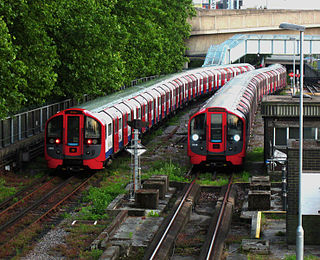
London Underground rolling stock includes the electric multiple-unit trains used on the London Underground. These come in two sizes, smaller deep-level tube trains and larger sub-surface trains of a similar size to those on British main lines, both running on standard gauge tracks. New trains are designed for the maximum number of standing passengers and for speed of access to the cars.

The London Underground 1992 Stock is a type of rolling stock used on the Central and Waterloo & City lines of the London Underground. A total of 85 eight-car trains were built for the Central line and 5 four-car trains were built for the Waterloo & City line.

The Standard Stock title was applied to a variety of Tube stock built between 1923 and 1934, all of which shared the same basic characteristics, but with some detailed differences. This design is sometimes referred to as 1923 Tube Stock, 1923 Stock, or Pre 1938 Stock. Most of the Standard Stock was built to replace the first generation of "Gate Stock" Tube trains or to provide additional trains for extensions built in the 1920s and early 1930s. Standard Stock cars consisted of motor cars, with a driver's cab, behind which was a "switch compartment" occupying approximately one-third of the length of the car, plus trailer cars and "control trailers", with a driving cab but no motor. All were equipped with air operated sliding doors. The guard's door on the earlier trains was a manually operated, inward-opening hinged door.

The British Rail Class 487 electric multiple units were built by English Electric in 1940, for use on the Waterloo & City line.

The Metropolitan District Railway, also known as the District Railway, was a passenger railway that served London, England, from 1868 to 1933. Established in 1864 to complete an "inner circle" of lines connecting railway termini in London, the first part of the line opened using gas-lit wooden carriages hauled by steam locomotives. The Metropolitan Railway operated all services until the District Railway introduced its own trains in 1871. The railway was soon extended westwards through Earl's Court to Fulham, Richmond, Ealing and Hounslow. After completing the inner circle and reaching Whitechapel in 1884, it was extended to Upminster in Essex in 1902.

The London Underground 1962 Stock was a type of London Underground tube train built for use on the Central line. They were used on the Central line between 1962 and 1995, with some later being transferred to the Northern line where they were used until 1999.

Hainault is a London Underground station in Hainault, east London, England. The station is on the Central line between Fairlop and Grange Hill stations. Since 2 January 2007, the station has been in Travelcard Zone 4. It is also home to one of the three Central line depots.

Chigwell is a London Underground station in the town of Chigwell in the Epping Forest district of Essex. It is located on the Hainault Loop of the Central line, between Grange Hill and Roding Valley stations.

The London Underground 1960 Stock was a class of electric multiple unit for the London Underground Central line. Twelve motor cars were supplied by Cravens, and pairs were made up to four cars by the addition of two converted standard stock trailers. A production run of 338 motor cars was shelved, due to the time needed to assess the new features and the cost of converting the trailer cars. Some of the pre-1938 trailers were later replaced by 1938 stock trailers.
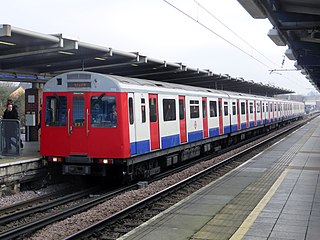
The London Underground D78 Stock, commonly referred to as D Stock, was a type of sub-surface rolling stock which operated on the District line of the London Underground, except on the Wimbledon to Edgware Road service. The first units were withdrawn in January 2015 with the last withdrawn on 21 April 2017.
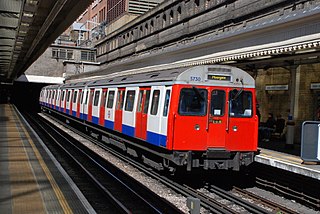
The London Underground C69 and C77 Stock, commonly referred to as the C Stock, was a type of sub-surface rolling stock used on the Circle, District and Hammersmith & City lines of the London Underground between 1970 and 2014. They were replaced by the S7 Stock.

The London Underground 1967 Stock was a type of deep-level train that operated on the Victoria line of the London Underground from the line's opening on 1 September 1968 until 30 June 2011. It was also used on the Central line between Woodford and Hainault between 21 February 1968 and 1984, as the same automatic train operation (ATO) system was used on both lines.
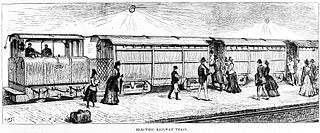
Electric locomotives were first used on the London Underground when the first deep-level tube line, the City and South London Railway (C&SLR), was opened in 1890. The first underground railways in London, the Metropolitan Railway (MR) and the District Railway (DR), used specially built steam locomotives to haul their trains through shallow tunnels which had many ventilation openings to allow steam and smoke to clear from the tunnels. It was impractical to use steam locomotives in the small unvented tubular tunnels of the deep-level lines, and the only options were rope haulage or electric locomotives.
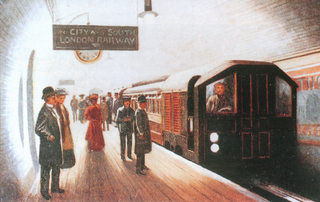
The Central London Railway Stock were electric multiple units composed of trailers that had been converted from carriages designed to be hauled by electric locomotives with new motor cars. The Central London Railway opened in 1900 with electric locomotives hauling wooden carriages, but the heavy locomotives caused vibrations that could be felt in the buildings above the route. It was found that conversion to electric multiple units solved the problem, so new motor cars were bought and replaced all the locomotives by June 1903. Trains normally ran with six-cars, four trailers and two motor-cars. Some trailers were equipped with control equipment to allow trains to be formed with three cars.

The history of the District line started in 1864 when the Metropolitan District Railway was created to create an underground 'inner circle' connecting London's railway termini. The first part of the line opened using Metropolitan Railway gas-lit wooden carriages hauled by steam locomotives. The District introduced its own trains in 1871 and was soon extended westwards through Earl's Court to Fulham, Richmond, Ealing and Hounslow. After completing the 'inner circle' and reaching Whitechapel in 1884, it was extended to Upminster in East London in 1902. To finance electrification at the beginning of the 20th century, American financier Charles Yerkes took it over and made it part of his Underground Electric Railways Company of London (UERL) group. Electric propulsion was introduced in 1905, and by the end of the year electric multiple units operated all of the services.
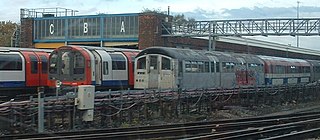
Hainault depot is a traction maintenance depot on the London Underground Central line, between Hainault and Grange Hill stations, now in the London Borough of Redbridge, England. Until boundary changes in 1998, part of the depot was in Epping Forest District. Construction began in 1939, but was delayed by the onset of the Second World War, and was not completed until 1948. It has stabled three generations of trains, Standard stock, 1962 stock and 1992 stock. It has also housed trains of the experimental 1960 stock, both when it was conventionally controlled and during trials of Automatic Train Operation (ATO) in preparation for the construction of the Victoria line. Some of the 1967 stock destined for the Victoria line was also stabled at the depot while its ATO equipment was tested and commissioned on the Woodford to Hainault Branch.

Acton Works is a London Underground maintenance facility in West London, England. It is accessed from the District line and Piccadilly line tracks to the east of Acton Town station, and was opened in 1922. It was responsible for the overhaul of rolling stock, and gradually took on this role for more lines, until the formation of the London Passenger Transport Board in 1933, when all major overhauls of underground vehicles were carried out at the works. By 1985, when rolling stock had become more reliable and maintenance intervals had increased, this function was devolved to depots on each line. Subsequently, Acton continued to overhaul major items after they had been removed from trains at the depots, and tendered for work, which included the conversion of the A60 Stock to One Person Operation. It is likely to be reorganised and expanded to house the departments displaced from Lillie Bridge Depot which is being demolished as part of the redevelopment of Earls Court Exhibition Centre.
























